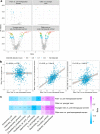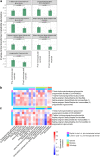Menopause Is Associated with an Altered Gut Microbiome and Estrobolome, with Implications for Adverse Cardiometabolic Risk in the Hispanic Community Health Study/Study of Latinos
- PMID: 35675542
- PMCID: PMC9239235
- DOI: 10.1128/msystems.00273-22
Menopause Is Associated with an Altered Gut Microbiome and Estrobolome, with Implications for Adverse Cardiometabolic Risk in the Hispanic Community Health Study/Study of Latinos
Abstract
Menopause is a pivotal period during which loss of ovarian hormones increases cardiometabolic risk and may also influence the gut microbiome. However, the menopause-microbiome relationship has not been examined in a large study, and its implications for cardiometabolic disease are unknown. In the Hispanic Community Health Study/Study of Latinos, a population with high burden of cardiometabolic risk factors, shotgun metagenomic sequencing was performed on stool from 2,300 participants (295 premenopausal women, 1,027 postmenopausal women, and 978 men), and serum metabolomics was available on a subset. Postmenopausal women trended toward lower gut microbiome diversity and altered overall composition compared to premenopausal women, while differing less from men, in models adjusted for age and other demographic/behavioral covariates. Differentially abundant taxa for post- versus premenopausal women included Bacteroides sp. strain Ga6A1, Prevotella marshii, and Sutterella wadsworthensis (enriched in postmenopause) and Escherichia coli-Shigella spp., Oscillibacter sp. strain KLE1745, Akkermansia muciniphila, Clostridium lactatifermentans, Parabacteroides johnsonii, and Veillonella seminalis (depleted in postmenopause); these taxa similarly differed between men and women. Postmenopausal women had higher abundance of the microbial sulfate transport system and decreased abundance of microbial β-glucuronidase; these functions correlated with serum progestin metabolites, suggesting involvement of postmenopausal gut microbes in sex hormone retention. In postmenopausal women, menopause-related microbiome alterations were associated with adverse cardiometabolic profiles. In summary, in a large U.S. Hispanic/Latino population, menopause is associated with a gut microbiome more similar to that of men, perhaps related to the common condition of a low estrogen/progesterone state. Future work should examine similarity of results in other racial/ethnic groups. IMPORTANCE The menopausal transition, marked by declining ovarian hormones, is recognized as a pivotal period of cardiometabolic risk. Gut microbiota metabolically interact with sex hormones, but large population studies associating menopause with the gut microbiome are lacking. Our results from a large study of Hispanic/Latino women and men suggest that the postmenopausal gut microbiome in women is slightly more similar to the gut microbiome in men and that menopause depletes specific gut pathogens and decreases the hormone-related metabolic potential of the gut microbiome. At the same time, gut microbes may participate in sex hormone reactivation and retention in postmenopausal women. Menopause-related gut microbiome changes were associated with adverse cardiometabolic risk in postmenopausal women, indicating that the gut microbiome contributes to changes in cardiometabolic health during menopause.
Keywords: gut microbiome; menopause.
Conflict of interest statement
The authors declare a conflict of interest. Dr. Santoro is a consultant with Ansh Labs and ASTELLAS/Ogeda, and receives grant support from Menogenix, Inc. outside the submitted work. All other authors declare no competing financial interests.
Figures






References
-
- El Khoudary SR, Aggarwal B, Beckie TM, Hodis HN, Johnson AE, Langer RD, Limacher MC, Manson JE, Stefanick ML, Allison MA. 2020. Menopause transition and cardiovascular disease risk: implications for timing of early prevention: a scientific statement from the American Heart Association. Circulation 142:e506–e532. doi:10.1161/CIR.0000000000000912. - DOI - PubMed
-
- Matthews KA, Crawford SL, Chae CU, Everson-Rose SA, Sowers MF, Sternfeld B, Sutton-Tyrrell K. 2009. Are changes in cardiovascular disease risk factors in midlife women due to chronological aging or to the menopausal transition? J Am Coll Cardiol 54:2366–2373. doi:10.1016/j.jacc.2009.10.009. - DOI - PMC - PubMed
Publication types
MeSH terms
Substances
Grants and funding
LinkOut - more resources
Full Text Sources
Miscellaneous

